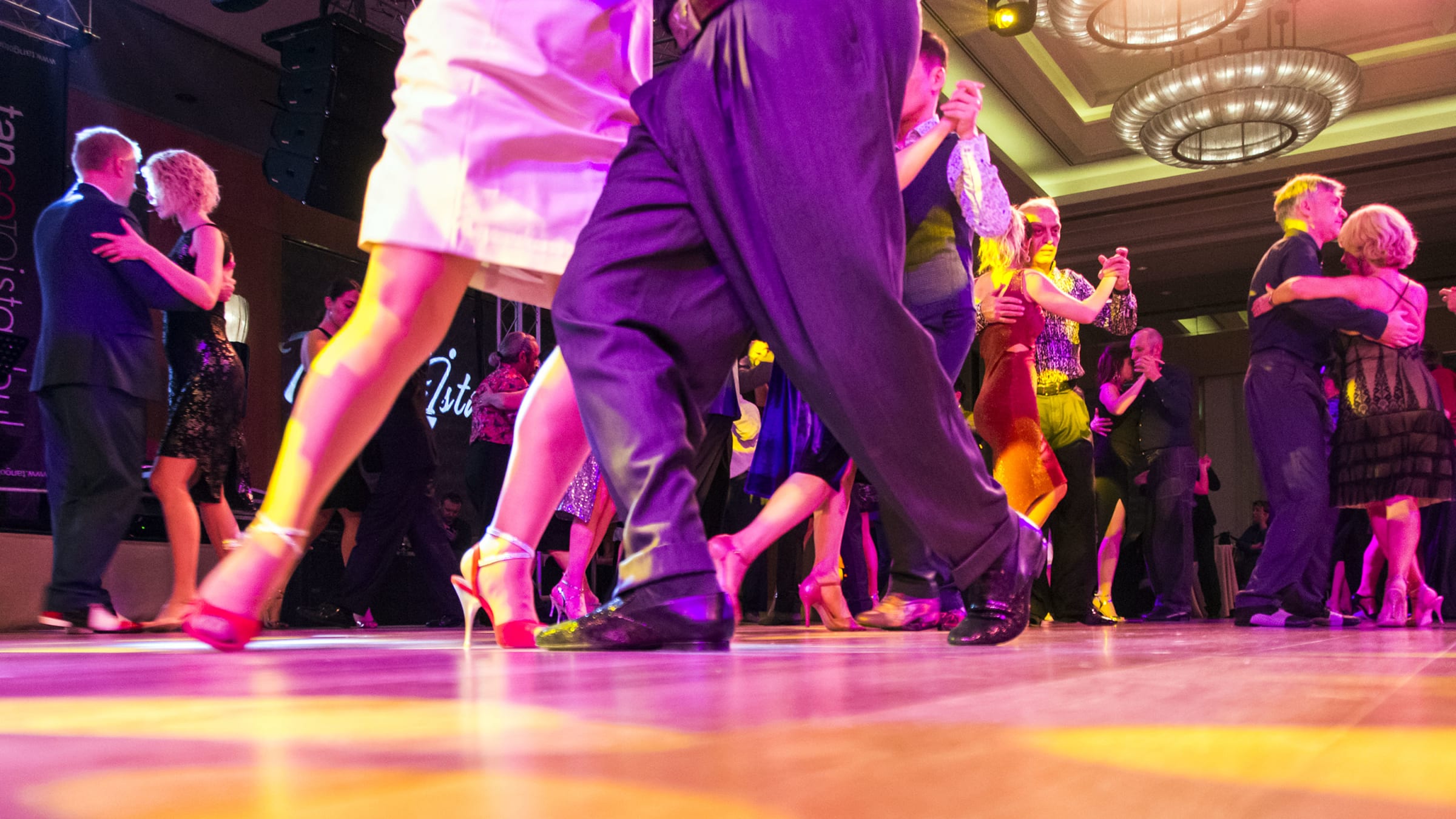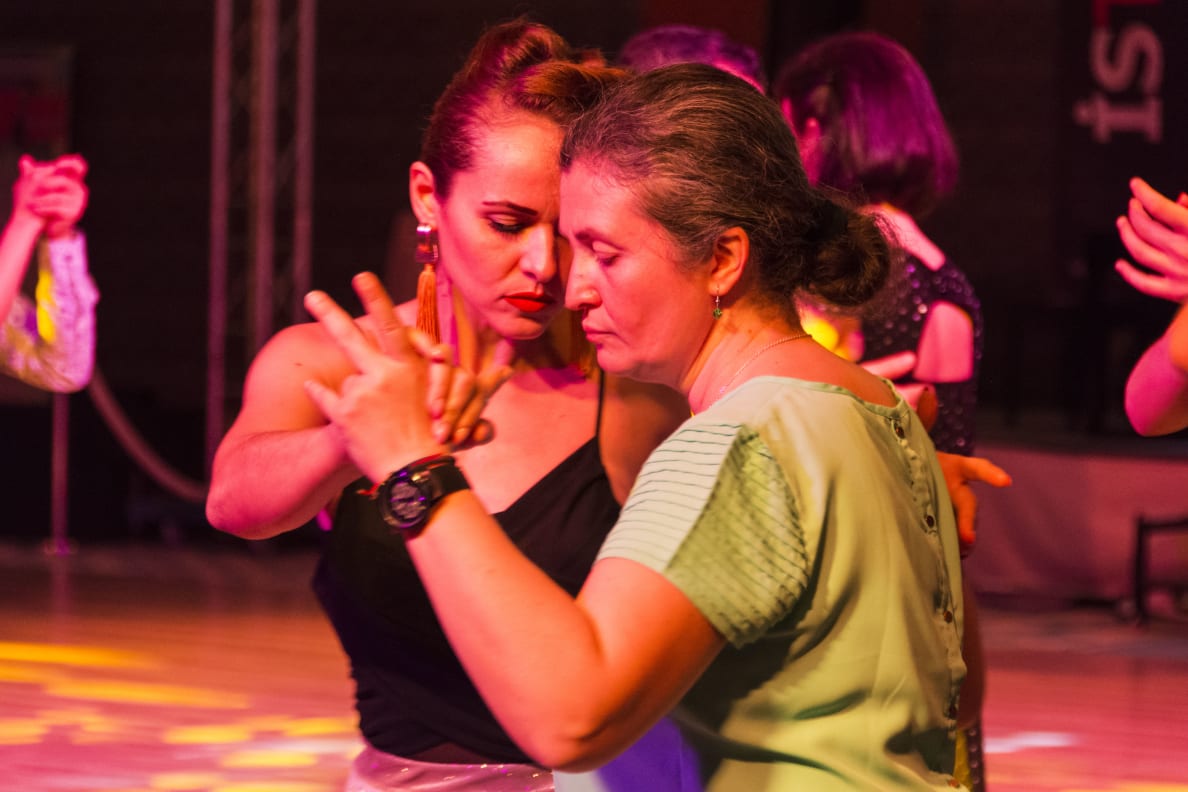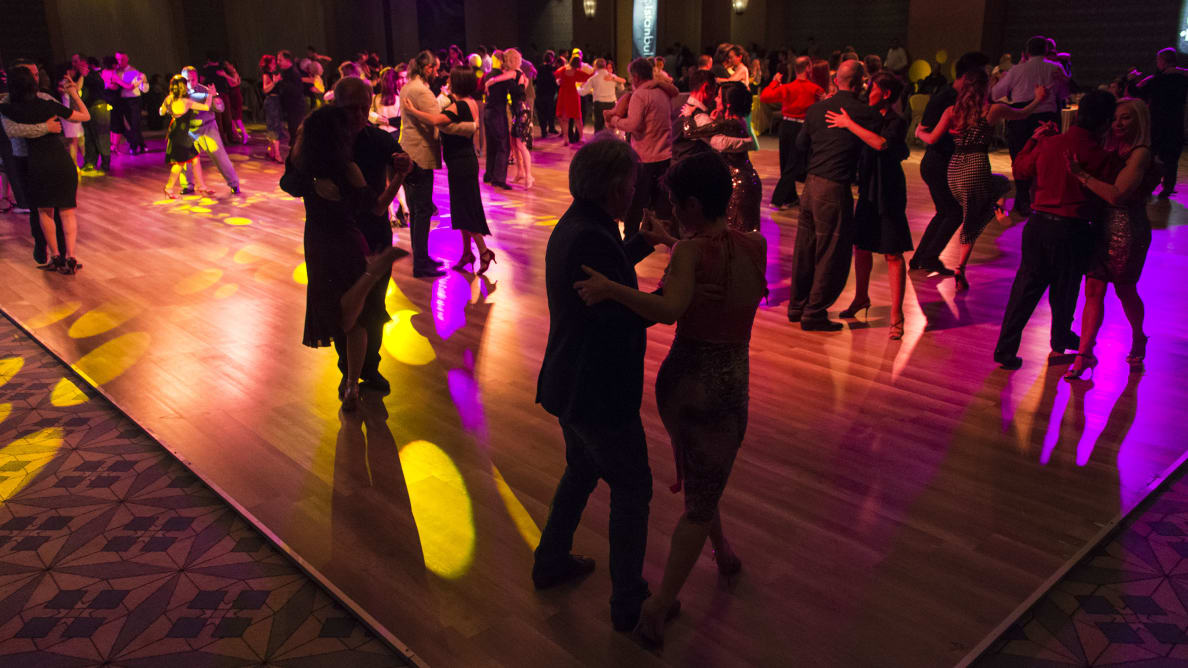The Last Tango in Istanbul Before Coronavirus

Courtesy Demetrios Ioannou
The legendary city straddling two continents is the world’s second largest for tango. As the deadly virus descended on the city, dancers gathered for one final heated embrace.
The last milonga on March 13 was canceled, officially, but it happened anyway—a secret gathering of Istanbul’s devoted tango dancers. There was talk about the virus, of course, and the organizers of this milonga insisted everyone wash their hands as soon as they entered the smoky dim-lit fourth floor bar. But then, a dozen couples wrapped their arms around each other and leaned into the tango. High above the stress of the city, away from the weight of an incoming pandemic, the event was a bubble of subversive joy. It felt intimate, dangerous. Below, Istanbul seethed. Up here, they tangoed.
Istanbul is considered the second largest city in the world for tango, behind only Buenos Aires. On a normal week, there are 25 milongas spread throughout the city, in fancy hotels and quiet restaurants and reappropriated yacht clubs.
Hakan Sulyeman is a regular at Istanbul’s milongas, the social events where people meet to dance tango. He dances three or four times a week, and his friend Monica Marks was back in town to dance until her feet bled. She started dancing tango in Istanbul, but left first for New York City and now lives in Abu Dhabi. Neither place has a tango scene to match the one in Istanbul. Throughout the week, the specter of the virus lingered over every milonga. The crowds were thinner, a tremolo of worry undercut the lilt of the tango music. But every night, still, there was dancing, there was embrace, there was connection.
“So many of these people came to tango when they were lonely or going through something,” Monica said as she sipped water after a particularly energetic milonga dance. “I don’t think a virus would make them stop coming. What else would they do?”
Unbeknownst to Monica, Hakan, and Istanbul’s tango community, the milonga on March 13 would be the last. At midnight on March 17, the city had shut down. Coronavirus was here. The tango stopped.
“Having danced in a lot of cities now, Istanbul is widely known to be a tango mecca, if not THE tango mecca, outside of Buenos Aires,” says Monica. “It’s fascinating because people have this idea about a 99 percent Muslim country, it doesn’t gel. But it’s actually huge.”
Tango dancing originated in the late 19th century in Argentina but took off at the beginning of the 20th century, spreading to North America and Europe and growing in popularity thanks in part to the accessibility of gramophone records. It owes its unique style to Argentina’s immigrants of that era, drawing on African, European, and indiginous influences. Tango’s Golden Age occurred between the 1930s and 1950s before declining due to Argentina’s military governance and coups d’état, and didn’t regain its popularity until the end of the 20th century.
Tango’s dominance in Istanbul can be traced to that worldwide tango revival in the 1990s. A man named Metin Yazır was one of the earliest Turkish adopters of tango, discovering it in Germany in the late ’90s and training the first batch of tango teachers in Istanbul. From there, the dance took root in the city. Monica and Hakan theorize that some of Turkey’s unique characteristics have allowed tango to flourish.
“One idea I’ve heard some people guess at is that Istanbul is the sort of place where there’s enough social openness that you have a strong community of people that are willing to touch each other in that way, but it’s still closed enough that doing so is taboo,” posits Monica. “It tends to draw a younger, more culturally and politically contrarian [community] than a lot of other activities.”
That youthfulness and willingness to experiment with form differentiates the Turkish tango scene from much of the rest of the world. Some of that is thanks to those original teachers, who built the architecture of the Turkish tango community. There are nearly 50 brick-and-mortar tango studios in Istanbul, and enthusiastic students dance a wide variety of styles of tango, fearlessly mixing up forms and creating an organic, evolving, living dance.

"Tango dancers from all around the world, meet every year at the International Tango Festival of Istanbul. This was the 12th year."
Courtesy Demetrios Loannou
Dancers from all over the world flock to Istanbul for tango, whether to buy their custom-made shoes at shops dedicated exclusively to tango footwear or to participate in the city’s active and vibrant dance scene. In early March, a large international tango festival descended on the ornate Ottoman-era Atik Pasha Palace (currently the Four Seasons Bosphorus hotel) on the Bosphorus shore, with more than 300 people packing themselves into the dance hall. The lights bathed the dancers in magenta and honey, and the speakers spooled out the crackle of old records as song after song of classic tango music played.
Dr. Onur Kahveci stood at the entrance to the dance hall, selling his book about the connection between quantum physics and tango dancing. “With quantum physics, we’re all connected,” he preached exuberantly. “With tango, we’re connected, men and women!”
The hall was a blur of sparkles, satin, lace and skin, slithering by in slow, sensual embraces. Women passed by with tattoos that peeked out from strappy dresses and strappy shoes, shoulder blades and ankles hinting at their lives outside of tango. Legs lifted, feet hovered, bodies twisted. A man with a single dangling earring danced by with an emphatic red lipstick mark on his neck. Old men danced with young women, old women danced with young men, women danced with women, couples who had never met simulated the deepest longing.
A woman named Adina, who came to the festival from Romania, had dressed to be a leader, not a follower, and intimately embraced other beautiful women in the dance. “We didn’t have enough men, and we needed a leader,” she explained, when asked how she decided to dance the lead. “I’ve danced with a person from Kazakhstan, from Turkey, Hungarian… everybody except the Italian people, they don’t come this year.”

"Adina, a dancer from Romania is dressed as a leader, because as she said, in her country not many men dance tango and most usually women have to dance with each other."
Courtesy Demetrios Loannou
Turkey had halted all flights from Italy earlier in the week, on March 1. There was pity and sympathy for the Italian tango dancers, locked in their homes. It felt sad and far away. Poor Italy.
It didn’t feel like Italy’s plight would touch the tango dancers of Istanbul, however. Monica had arrived in Istanbul in early March, certain the milongas would be as exuberant as ever. Istanbul was where her tango obsession began, and the entire point of her return visit was to dance.
“I never thought that I would be interested in tango,” Monica says. “As an American, my idea of tango was very ballroom-tango, rose-in-the-mouth bullshit. Very dramatic, very rigid. I had zero interest.” Hakan introduced her to the dance in Istanbul, after taking classes at his university, and together they dove head-first into the city’s tango scene. Quickly, Monica discovered that her previous ideas of tango were completely wrong. Tango was about connection, about bodies as art.
“A tango teacher on Istiklal [Avenue] says when you start dancing with a person, you need to write the story of them. It sounds really romantic,” says Hakan. “It’s writing a story in the dance.”
Monica was hooked from her first milongas. There, she saw “people creating museum artwork with their feet. People looking like they’re going to cry. Smiling, laughing. Styles of music that were playful and fun and fast. Styles of music that were slow and much more dramatic,” she says. “I saw myself there. There’s room for laughter, there’s room for teasing, there’s room for play.”
That tactile, collaborative nature of tango draws in people who have a strong need for touch. It’s a dance of closeness. Hakan’s favorite form of tango is classic and dramatic, and that’s something he communicates with his partners through movement. “When you have to move slowly, and when you expect the person to follow you in the same way, really really slowly,” he says, “you find the person who likes the same frequency in the dance, the one who connects well with your body.”
“I think it’s a really important part of our humanity that we're able to touch a stranger, and dance with a stranger,” says Monica. “You go and you embrace someone and you create art with your bodies whilst dancing in a hug, and do that with multiple people in the night without saying a word. And that's magical.”
The festival ended on March 8. On March 11, the first confirmed coronavirus case was reported in Turkey.
On March 12, after a long meal at a local Italian restaurant, Monica and Hakan went to a milonga on the Asian-side neighborhood of Kadikoy that was still proceeding as planned, even as other popular milongas around the city started to cautiously cancel. A popular milonga at a nearby yacht club had cancelled their event through the end of the month. The organizer of this Kadikoy milonga came over to Monica and Hakan’s table to say hello as they put on their tango shoes, and confided that his twice-monthly milonga was certainly quieter tonight, “because of corona.”

"A group of international dancers gathered at a former Ottoman Palace in Istanbul to tango."
Courtesy Demetrios Loannou
But the music started, the dancers coupled off, and the night swirled by in a flurry of tango.
The next night, Hakan and Monica went to Taksim for the “cancelled” milonga, which went on anyway, because this is Istanbul and this is tango. The idea of the rush of tango dancing ever stopping here was almost unimaginable. The young crowd drank wine and local beer, someone coughed, someone laughed, the DJ smoked a cigarette as he cued up the next tanda. All the dancers thronged the dance floor, and the tango went on.
Just after midnight on March 17, only a few days after the secret milonga, Turkey closed all social spaces. The first COVID-19 death was reported later that day.
The dancing stopped.
“It's almost impossible to reconcile the whiplash of that,” Monica says, two weeks after the end, “that one night you can be in a crowded dance hall full of strangers, drinking your wine, and listening to music from the golden era of tango. And then, two days later, the whole world has stopped.” She left Istanbul on one of the final flights back to Abu Dhabi, the weekend of the last milonga. Her limited options for tango dancing in the UAE have been curtailed completely, severing her from her favored coping mechanism.
“I'm a person who would ride out any pandemic most happily by tango dancing through it.”
Hakan remains in Istanbul, but he lives alone, and finds himself suddenly cut off from the dance that sustains him. “I wish there was someone whom I was living with to dance tango,” he laments. “It is something that I share with people and I can’t do it by myself.”
“We all crave dancing,” says Hakan, “Because big parts of our social lives are based on these gatherings and events related with tango. We all miss it a lot.”
As of April 17, Turkey has not ordered a full lockdown to control the virus. Everyone must wear masks, almost all the shops and restaurants have closed, the parks and seasides are restricted, and everyone over the age of 65 and under 20 must stay inside, and rolling weekend lock-ins have been declared. In an attempt to keep the wheels of the fragile economy turning, though, many people continue to go to work. The cases are rising sharply. A month after the first case on March 11, there are more than 78,000. The government asks everyone to socially distance themselves, and Istanbul’s sidewalks are mostly empty, devoid of the two-kiss greetings and close conversations and churning crowds that usually fill the city. There is no touching. There is no dancing. There is dread.
The milongas of early March feel like a memory from a lost world.
“That was like a brilliant moment of tactile poetry right before the tsunami,” Monica reflects.
“It felt like a poetic coda on the end of an era that we didn't know was the ending, or a poetic coda to normalcy. There was a delightful innocence about it.” She smiles. “It felt wonderful to be there.”